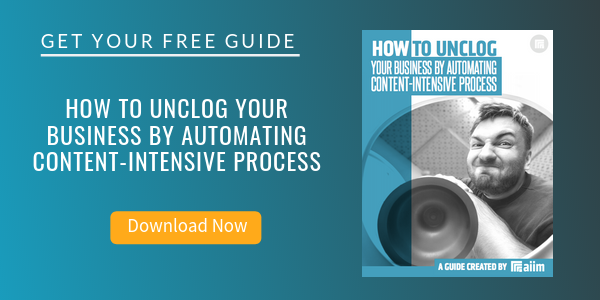
A Six Pack of Content on HR, CRM and ERP
Enterprise Resource Planning (ERP) | Business Process Management (BPM) | CRM | Human Resources
I've been working on a project over the past few weeks focused on the role that content plays in core business processes, specifically Human Resources (HR), Customer Relationship Management (CRM), and Enterprise Resource Planning (ERP).
The background for this is a data point from one of AIIM's surveys last year -- "62% of organizations say that using content in the context of lead business systems is a problem."
The challenge for many organizations is that their legacy ECM systems were implemented with an eye toward automating a single mission critical, document-intensive, large scale process. Organizations realized huge benefits in doing so, but have struggled in extending their ECM experience to the next level of business process challenges.
Many organizations have moved to single-process SaaS applications out of frustration with the lack of agility in their existing systems. The challenge with this approach is that it solves an immediate problem, but it creates a another -- the failure to view content in a more agnostic way creates the likelihood that well-intentioned SaaS efforts will create a new generation of siloed and incompatible information repositories, this time in the cloud. The solution is to think strategically about how content assets are integrated into lead enterprise applications -- and not take this for granted. That was this focus of my project, focusing on three lead enterprise processes.
Content Management and HR
The best way to think about HR process automation is by thinking about it over the lifecycle of an employment relationship and the kinds of documents that are typical in each stage of the life cycle. (For illustration, the compliance documents listed below are for the U.S. These obviously vary by country, making it even more important to standardize and automate wherever possible.)
- Recruitment and Onboarding (resumes, interviews, offer letters, job description, I-9 forms, references)
- Payroll and Compensation (incentive plan documentation, W-2 forms, garnishments, leave documentation)
- Benefits (plan documentation, beneficiaries, dependents, Family and Medical Leave Act documentation)
- Performance Management (reviews, disciplinary actions, promotions)
- Learning and Development (certifications, training)
- Separation or Retirement (resignation and separation letters, COBRA, vacation payouts)
There is a high degree of manual work in each of these processes. 63% of organizations say that HR processes are less than 50% automated. 50% of organizations say that managing unstructured information is a huge challenge in automating HR processes. (AIIM, 2018, Enhancing Your RPA Implementation with Intelligent Information)
FREE Infographic: A Day in the Life of an HR Professional
Content Management and CRM
Every organization wants to increase agility and productivity by extracting maximum value from its processes and content. Organizations need to bridge the silos created by disparate lead applications to seamlessly pull structured and unstructured information together and present the whole story to the customer relationship management (CRM) users who need it. Easy access to documents and content is a key requirement in fully leveraging a CRM system. 95% of CRM users want easy access to the latest version of their files and documents and 55% of CRM customers see “ease of use” as the most important feature.
The lack of integration between content capabilities and CRM systems is clearly a recipe for frustration that takes these forms:
- Incomplete or missing information
- Longer time to resolve customer inquiries
- Limited collaboration for sales teams on opportunities
- Critical customer documents not linked to information in the CRM system
- Missed up-sell and cross-sell opportunities
- Gaps between inconsistent and out-of-date information in multiple systems
- Inadequate governance capabilities in CRM system resulting in non-compliance and legal exposure
FREE Infographic: A Day in the Life of a Customer
Content Management and ERP
Organizations that are able to extend ECM capabilities in a standardized and predictable way into their ERP systems yield significant benefits:
- Productivity of the procurement team is increased.
- Employees in procurement and vendor management are supported with powerful document management capabilities providing centrally managed templates for document creation.
- Data quality and consistency is optimized by a fully automated data synchronization between ERP and ECM.
- Full-text search allows users to leverage all existing information and documents in procurement processes (for example, in contract negotiation).
- Effective document centric collaboration with suppliers and other departments allows traceable and transparent documentation of all supplier interactions.
- “Maverick procuring” is reduced through more consistent documentation of communications with internal clients, procurement/legal departments and suppliers.
- All content in the procurement department is governed by corporate records management program rather than by the governance functionality that resides within the ERP system.
FREE Infographic: A Day in the Life of a Procurement Processional
I thought I would share some of the infographics and tip sheets that are part of this project all in one place.
The infographics all take the form of "A Day in the Life." I highlight the role that content plays in three key major enterprise processes, HR, CRM, and ERP.
- A Day in the Life of an HR Professional
- A Day in the Life of a Customer
- A Day in the Life of a Procurement Processional
The Tip Sheets are more thematic:
- What does it mean for HR processes to be both Intelligent and Connected?
- What does it mean for CRM processes to be both Intelligent and Connected?
- What does it mean for Procurement processes to be both Intelligent and Connected?
I hope you enjoy them.
About John Mancini
John Mancini is the President of Content Results, LLC and the Past President of AIIM. He is a well-known author, speaker, and advisor on information management, digital transformation and intelligent automation. John is a frequent keynote speaker and author of more than 30 eBooks on a variety of topics. He can be found on Twitter, LinkedIn and Facebook as jmancini77. Recent keynote topics include: The Stairway to Digital Transformation Navigating Disruptive Waters — 4 Things You Need to Know to Build Your Digital Transformation Strategy Getting Ahead of the Digital Transformation Curve Viewing Information Management Through a New Lens Digital Disruption: 6 Strategies to Avoid Being “Blockbustered” Specialties: Keynote speaker and writer on AI, RPA, intelligent Information Management, Intelligent Automation and Digital Transformation. Consensus-building with Boards to create strategic focus, action, and accountability. Extensive public speaking and public relations work Conversant and experienced in major technology issues and trends. Expert on inbound and content marketing, particularly in an association environment and on the Hubspot platform. John is a Phi Beta Kappa graduate of the College of William and Mary, and holds an M.A. in Public Policy from the Woodrow Wilson School at Princeton University.


